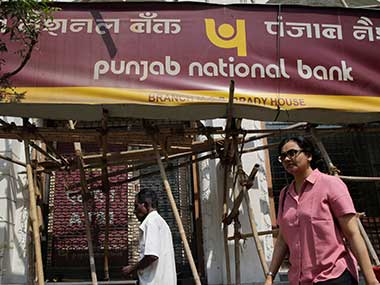Editor's note: The Rs 11,400-crore bank fraud in Punjab National Bank, that was perpetrated by billionaire Nirav Modi in collusion with a few bank employees, has once again brought governance practices in Public Sector Banks (PSBs) back to public debate. There are questions raised on the way these entries function. A political blame game is on. But the problems in this sector are far beyond one instance of fraud. After five decades of bank nationalisation, India's public sector banks face deeper structural problems ranging from poor management practices, ineffective risk-management systems, vulnerability to a political-corporate nexus, large chunk of bad loans and lack of sufficient autonomy. Firstpost will publish a multi-part series that examines the serious structural problems that have engulfed India's state-run banks and the likely course of this industry, which constitutes 70 percent of India's banking sector assets. You can read the first part of the series here.
Warning bells ring
On 24 November, 2010, at around noon, the Central Bureau of Investigation (CBI) called a press conference in Mumbai to make an important announcement. As the media waited eagerly for the finer details, the central agency announced the arrest of eight bank officials including the then chief executive officer (CEO) of LIC Housing Finance Ltd in Mumbai, a top officer of LIC and officials of Bank of India (BoI), Central Bank of India and Punjab National Bank (PNB). During the course of the presser, the CBI claimed to have broken the back of a corporate loan racket, wherein bank officials allegedly took bribe from middlemen on behalf of companies to arrange loans to them that wouldn’t be given under normal course of credit operations.
As the details of the 'corporate loan scam' or 'bribe-for-loan scam' (as media the called it) unveiled, the then Union finance minister Pranab Mukherjee warned banks then to take action against the bankers involved in the scam and put proper checks and balances to avoid the recurrence of such frauds. It is another thing entirely that the CBI could never follow up with a strong case in the court of law. But the big takeaway is that bankers never learned their lesson.
It's all about middlemen
The instances of fraudulent transactions and loan scams involving bank officials continued. This included both and big and small frauds — Citibank fraud, Bank of Baroda forex scam, Syndicate Bank fraud and several other lesser-known scams. In most instances, the victims were public sector banks and culprits their own officials. Most cash-for-loan scams happened through middlemen. "There are many advisory firms that arrange loans for companies from banks, offering bank officials kickbacks. Big firms don’t need them but mid-sized and small companies go after these middlemen to approach bankers," said a senior banker with experience of over 30 years, who didn’t wish to be named.
"The bribe for the banker may not be in the form of cash but other favours that aren't easy to detect in the event of an investigation," he continued. There were instances of bankers getting caught accepting even not-so-expensive watches or gold ornaments. "Some do it for money, some for relations and some for even flattery. If you think about it, it is so strange that sometimes the reasons for people falling for illegal activities are trivial," he added. Some bankers cite the relatively low wages offered by state-run banks to their officers in comparison with private and foreign counterparts as a motivating factor to commit fraud and take bribes.

File image of Nirav Modi. Nirav Modi official Facebook page
Checks in place, but no one cares
Looking at PNB-like frauds, if someone thinks that there are no checks in place in the system, they are wrong. "There are checks but no one really cares," said another banker who too requested anonymity. He takes the example of the LoU (Letters of Undertakings) fraud in PNB. If a branch-level official does a transaction of this manner for a period of seven years, it can get caught at different levels if any of the checks in place triggered this illegal activity.
For instance, the SWIFT messaging platform that was used by the perpetrators in the PNB case is subjected to a daily check by the branch manager, which is compulsory in any bank. Even if one imagines that this part failed, the branch manager has to do a daily tally of income and expenditure in the branch while one of the officers (not involved in the transactions) combs through the books to look for suspicious transactions, the official said. "Besides these daily checks, the bank does concurrent audit which happens concurrently throughout the year. Such fraud should have reflected there," the official said. This apart, there are RBI and government representatives on the boards of large banks who are supposed to keep an eye on all transactions and ensure that nothing goes amiss.
"But, it appears that all of them were sleeping when a fraud was developing," said the second banker. That apart, given the tremendous pressure on bankers to generate business, top-level officers often turn a blind eye to illegal business activities.
The art of acting too late
It's not just about fraud, but also about wrong credit decisions and the art of acting too late. Banks continued to support Kingfisher despite fully knowing that things were not looking good financially. Lenders offered to restructure Vijay Mallya's loan after realising that they had already thrown good money after bad. In March 2012, Kingfisher halted its international operations to Europe and Asian countries and cut down local flights to 110 to 125 a day with a fleet of 20 planes (down from from 340 flights earlier) to save money. By October 2012, the bird flapped its wings for the last time. Since then, it hasn’t seen the skies.
Kingfisher, once the second-largest airline in India, had little chances of resuming its operations since the necessary regulatory approvals were not in sight and its balance sheet was bleeding. The company's losses had expanded to Rs 2,142 crore for its fiscal fourth quarter ending in March 2013, compared with a net loss of Rs 1,150 crore a year earlier. The accumulated losses as of March 2013 stood at a whopping Rs 16,023 crore.
In early 2011, the bank consortium including SBI had converted debt amounting to Rs 1,400 crore into equity at a 60 percent premium to the prevailing market price. Going by the stock exchange data, on 31 March that year, there was preferential allotment to SBI and ICICI Bank due for conversion of compulsorily convertible preference shares into equity shares at a price of Rs 64.48 each. Remember, on that day, KFA shares closed at Rs 39.90 on the BSE. Within a few months, the share value had eroded so much that banks were put in a difficult position. Kingfisher last traded at Rs 1.36 on the BSE on 22 June, 2015. Banks are still fighting in courts to get the money back from Mallya, who is now in London and has waged a legal war on Indian banks. It is unlikely that banks will get their money back.
Mallya is only one case. There are several other cases of large loan defaults (at least two dozen of such cases are now with NCLT for bankruptcy proceedings), where banks have been caught off-guard. The latest is the Rotomac loan default case, where the size of the loan default is now estimated about Rs 3,700 crore. Here too banks acted too late. For instance, one of the lenders to Rotomac's Vikram Kothari, Bank of Baroda classified this account as an NPA way back in October 2015 and tagged this as a case of fraud in December 2017. But the bank moved to investigators only after the Nirav Modi scam broke out.
In this case too, there were warning signals that were less noticed. As this report points out, Mumbai's diamond merchants knew "Mehul and Nirav's businesses were failing". It’s just that bankers didn't have their ears to the ground. Frauds have become so rampant in India's banking sector in recent years, making a mockery of the regulator and risk-management tools in place. Between 1 January, 2015 and 31 March, 2017, as many as 5,200 officials of public sector banks have been punished for fraud. In PNB itself, 184 officials were caught for fraudulent activities during the same period, the report said.
What is surprising is that the Indian banking system has no fewer checks and balances than any other country, whether regulatory monitoring, auditing or internal checks, but all of these has failed when it comes to preventing fraud. That calls for a major overhaul.
Part I: Beyond PNB fraud, a deeper malaise lies in India’s state-run banks gifting them a slow death
Published Date: Feb 21, 2018 11:20 AM | Updated Date: Feb 21, 2018 11:20 AM



















